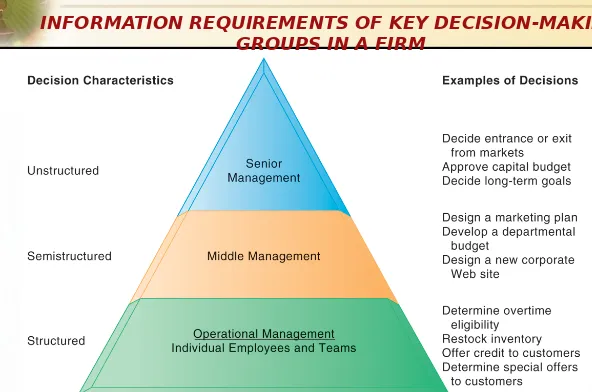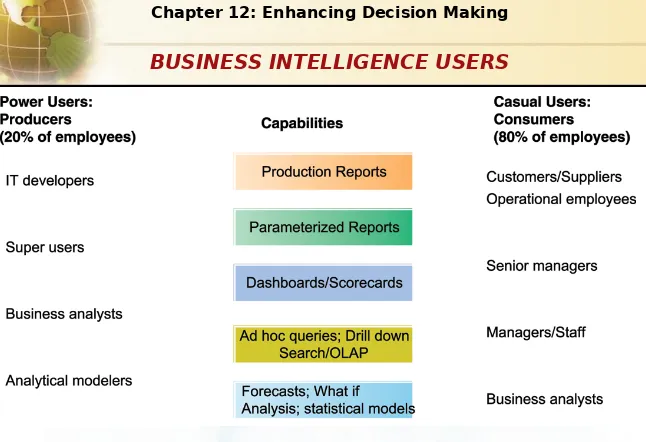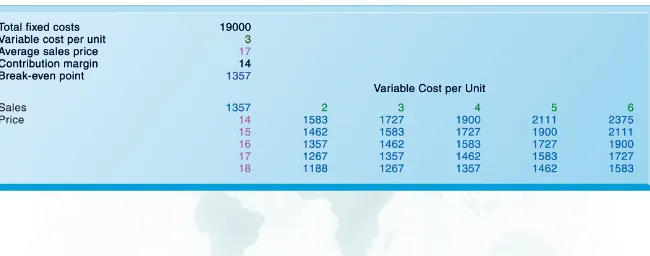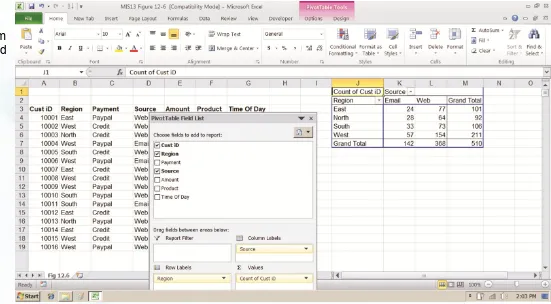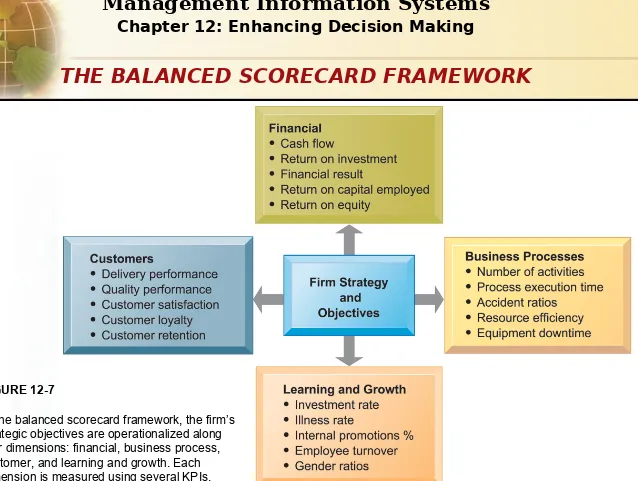6.1 Copyright © 2014 Pearson Education, Inc. publishing as Prentice Hall
Enhancing Decision
Making
Chapter 12
VIDEO CASES
Video Case 1: FreshDirect Uses Business Intelligence to Manage Its Online Grocery
Video Case 2: Business Intelligence Helps the Cincinnati Zoo
Instructional Video 1: FreshDirect’s Secret Sauce: Customer Data From the Website
12.2 Copyright © 2016 Pearson Education Ltd.
Management Information Systems
Chapter 12: Enhancing Decision Making
• What are the diferent types of decisions and how does the decision-making process work? How do information systems support the activities of managers and management decision making?
• How do business intelligence and business analytics support decision making?
• How do diferent decision-making
constituencies in an organization use
business intelligence? What is the role of information systems in helping people
working in a group make decisions more efficiently?
12.3 Copyright © 2016 Pearson Education Ltd.
Management Information Systems
Chapter 12: Enhancing Decision Making
•
Problem:
Extreme competition;
opportunities from new
technology
•
Solutions:
Use improved
statistical analysis to identify
player weaknesses and
strengths, use new metrics to
improve player and team
performance
•
Demonstrates the use of
business intelligence to develop
better performance metrics
12.4 Copyright © 2016 Pearson Education Ltd.
Management Information Systems
Chapter 12: Enhancing Decision Making
•
Business value of improved
decision making
–
Improving hundreds of thousands of
“small” decisions adds up to large annual
value for the business
•
Types of decisions:
–
Unstructured:
Decision maker must
provide judgment, evaluation, and insight
to solve problem
–
Structured:
Repetitive and routine;
involve defnite procedure for handling so
they do not have to be treated each time
as new
–
Semistructured:
Only part of problem has
clear-cut answer provided by accepted
procedure
12.5 Copyright © 2016 Pearson Education Ltd.
Management Information Systems
Chapter 12: Enhancing Decision Making
•
Senior managers:
– Make many unstructured decisions
– For example: Should we enter a new market?
•
Middle managers:
– Make more structured decisions but these may
include unstructured components
– For example: Why is order fulfllment report
showing decline in Minneapolis?
•
Operational managers, rank and
fle employees
– Make more structured decisions
– For example: Does customer meet criteria for credit?
12.6 Copyright © 2016 Pearson Education Ltd.
Management Information Systems
Chapter 12: Enhancing Decision Making
Senior managers, middle managers, operational managers, and employees have different types of decisions and information requirements.
FIGURE 12-1
12.7 Copyright © 2016 Pearson Education Ltd.
Management Information Systems
Chapter 12: Enhancing Decision Making
•
The four stages of the
decision-making process
1. Intelligence
• Discovering, identifying, and understanding the problems occurring in the organization
2. Design
• Identifying and exploring solutions to the problem
3. Choice
• Choosing among solution alternatives
4. Implementation
• Making chosen alternative work and continuing to monitor how well solution is working
12.8 Copyright © 2016 Pearson Education Ltd.
Management Information Systems
Chapter 12: Enhancing Decision Making
The decision-making
process is broken down into four stages.
FIGURE 12-2
12.9 Copyright © 2016 Pearson Education Ltd.
Management Information Systems
Chapter 12: Enhancing Decision Making
•
Information systems can only
assist in some of the roles
played by managers
•
Classical model of management:
fve functions
– Planning, organizing, coordinating,
deciding, and controlling
•
More contemporary behavioral
models
– Actual behavior of managers appears to be less systematic, more informal, less refective, more reactive, and less well organized than in classical model
12.10 Copyright © 2016 Pearson Education Ltd.
Management Information Systems
Chapter 12: Enhancing Decision Making
•
Mintzberg’s 10 managerial roles
–
Interpersonal roles
1. Figurehead 2. Leader
3. Liaison
–
Informational roles
4. Nerve center 5. Disseminator 6. Spokesperson
–
Decisional roles
7. Entrepreneur
8. Disturbance handler 9. Resource allocator 10.Negotiator
12.11 Copyright © 2016 Pearson Education Ltd.
Management Information Systems
Chapter 12: Enhancing Decision Making
•
Three main reasons why investments in
information technology do not always
produce positive results
1. Information quality
• High-quality decisions require high-quality information
2. Management flters
• Managers have selective attention and have variety of biases that reject information that does not conform to prior conceptions
3. Organizational inertia and politics
• Strong forces within organizations resist making
decisions calling for major change
12.12 Copyright © 2016 Pearson Education Ltd.
Management Information Systems
Chapter 12: Enhancing Decision Making
•
High-velocity automated
decision making
–
Made possible through computer
algorithms precisely defning steps for
a highly structured decision
–
Humans taken out of decision
–
For example: High-speed computer
trading programs
• Trades executed in 30 milliseconds
• Responsible for “Flash Crash” of 2010
–
Require safeguards to ensure proper
operation and regulation
12.13 Copyright © 2016 Pearson Education Ltd.
Management Information Systems
Chapter 12: Enhancing Decision Making
•
Business intelligence
–
Infrastructure for collecting, storing,
analyzing data produced by business
–
Databases, data warehouses, data
marts
•
Business analytics
–
Tools and techniques for analyzing
data
–
OLAP, statistics, models, data mining
•
Business intelligence vendors
–
Create business intelligence and
analytics purchased by frms
12.14 Copyright © 2016 Pearson Education Ltd.
Management Information Systems
Chapter 12: Enhancing Decision Making
Business
intelligence and analytics
requires a strong database
foundation, a set of analytic tools, and an involved management team that can ask intelligent questions and analyze data.
FIGURE 12-3
12.15 Copyright © 2016 Pearson Education Ltd.
Management Information Systems
Chapter 12: Enhancing Decision Making
•
Six elements in the business
intelligence environment
1. Data from the business
environment
2. Business intelligence
infrastructure
3. Business analytics toolset
4. Managerial users and methods
5. Delivery platform—MIS, DSS, ESS
6. User interface
12.16 Copyright © 2016 Pearson Education Ltd.
Management Information Systems
Chapter 12: Enhancing Decision Making
•
Business intelligence and analytics
capabilities
–
Goal is to deliver accurate real-time
information to decision makers
–
Main functionalities of BI systems
1. Production reports2. Parameterized reports 3. Dashboards/scorecards
4. Ad hoc query/search/report creation 5. Drill down
6. Forecasts, scenarios, models
12.17 Copyright © 2016 Pearson Education Ltd.
Management Information Systems
Chapter 12: Enhancing Decision Making
•
Business intelligence users
– 80 percent are casual users relying on
production reports
– Senior executives
• Use monitoring functionalities
– Middle managers and analysts • Ad-hoc analysis
– Operational employees • Prepackaged reports
• For example: sales forecasts, customer
satisfaction, loyalty and attrition, supply chain backlog, employee productivity
12.18 Copyright © 2016 Pearson Education Ltd.
Management Information Systems
Chapter 12: Enhancing Decision Making
Casual users are consumers of BI output, while intense power users are the producers of reports, new analyses, models, and forecasts.
FIGURE 12-4
12.19 Copyright © 2016 Pearson Education Ltd.
Management Information Systems
Chapter 12: Enhancing Decision Making
•
Production reports
–
Most widely used output of BI suites
–
Common predefned, prepackaged
reports
• Sales: Forecast sales; sales team performance
• Service/call center: Customer satisfaction; service cost
• Marketing: Campaign efectiveness; loyalty and attrition
• Procurement and support: Supplier performance
• Supply chain: Backlog; fulfllment status • Financials: General ledger; cash fow
• Human resources: Employee productivity; compensation
12.20 Copyright © 2016 Pearson Education Ltd.
Management Information Systems
Chapter 12: Enhancing Decision Making
•
Predictive analytics
–
Use variety of data, techniques to
predict future trends and behavior
patterns
• Statistical analysis • Data mining
• Historical data • Assumptions
–
Incorporated into numerous BI
applications for sales, marketing,
fnance, fraud detection, health care
• Credit scoring• Predicting responses to direct marketing campaigns
12.21 Copyright © 2016 Pearson Education Ltd.
Management Information Systems
Chapter 12: Enhancing Decision Making
•
Big data analytics
–
Big data: Massive datasets collected
from social media, online and in-store
customer data, and so on
–
Help create real-time, personalized
shopping experiences for major online
retailers
–
Smart cities
• Public records
• Sensors, location data from smartphones • Ability to evaluate efect of one service
change on system
12.22 Copyright © 2016 Pearson Education Ltd.
Management Information Systems
Chapter 12: Enhancing Decision Making
Read the Interactive Session and discuss the following questions
Interactive Session: Technology
• What management, organization, and technology factors were behind the Cincinnati Zoo losing
opportunities to increase revenue?
• Why was replacing legacy point-of-sale systems and implementing a data warehouse essential to an
information system solution?
• How did the Cincinnati Zoo beneft from business intelligence? How did it enhance operational
performance and decision making? What role was played by predictive analytics?
• Visit the IBM Cognos Web site and describe the
business intelligence tools that would be the most useful for the Cincinnati Zoo.
12.23 Copyright © 2016 Pearson Education Ltd.
Management Information Systems
Chapter 12: Enhancing Decision Making
•
Operational intelligence and
analytics
–
Operational intelligence: Business
activity monitoring
–
Collection and use of data generated
by sensors
–
Internet of Things
• Creating huge streams of data from Web activities, sensors, and other monitoring devices
–
Software for operational intelligence
and analytics enable companies to
analyze their Big Data
12.24 Copyright © 2016 Pearson Education Ltd.
Management Information Systems
Chapter 12: Enhancing Decision Making
Read the Interactive Session and discuss the following questions
Interactive Session: Management
• How did information technology change the way America’s Cup boats were managed and sailed?
• How did information technology impact decision making at Team USA?
• How much was technology responsible for Team USA’s America’s Cup victory? Explain your
answer.
• Compare the role of big data in Team USA’s
America’s Cup victory with its role in the German team’s 2014 World Cup victory described in the chapter-opening case.
12.25 Copyright © 2016 Pearson Education Ltd.
Management Information Systems
Chapter 12: Enhancing Decision Making
•
Location analytics
•
Ability to gain business insight from
the location (geographic) component
of data
• Mobile phones
• Sensors, scanning devices
• Map data
•
Geographic information systems
(GIS)
•
Ties location-related data to maps
•
Example: For helping local
governments calculate response times
to disasters
12.26 Copyright © 2016 Pearson Education Ltd.
Management Information Systems
Chapter 12: Enhancing Decision Making
•
Two main management
strategies for developing BI and
BA capabilities
1. One-stop integrated solution
– Hardware frms sell software that run
optimally on their hardware
– Makes frm dependent on single vendor— switching costs
2. Multiple best-of-breed solution
– Greater fexibility and independence
– Potential difculties in integration
– Must deal with multiple vendors
12.27 Copyright © 2016 Pearson Education Ltd.
Management Information Systems
Chapter 12: Enhancing Decision Making
•
Operational and middle
managers
–
Use MIS (running data from TPS) for:
• Routine production reports • Exception reports
•
“Super user” and business
analysts
–
Use DSS for:
• More sophisticated analysis and custom reports
• Semistructured decisions
12.28 Copyright © 2016 Pearson Education Ltd.
Management Information Systems
Chapter 12: Enhancing Decision Making
•
Decision support systems:
Support for semistructured
decisions
–
Use mathematical or analytical
models
–
Allow varied types of analysis
•
“What-if” analysis
•
Sensitivity analysis
•
Backward sensitivity analysis
•
Multidimensional analysis / OLAP
–
For example: pivot tables
12.29 Copyright © 2016 Pearson Education Ltd.
Management Information Systems
Chapter 12: Enhancing Decision Making
This table displays the results of a sensitivity analysis of the effect of changing the sales price of a necktie and the cost per unit on the product’s break-even point. It answers the question, “What happens to the break-even point if the sales price and the cost to make each unit increase or decrease?”
FIGURE 12-5
12.30 Copyright © 2016 Pearson Education Ltd.
Management Information Systems
Chapter 12: Enhancing Decision Making
In this pivot table, we are able to examine where an online training company’s customers come from in terms of region and advertising source.
FIGURE 12-6
A PIVOT TABLE THAT EXAMINES CUSTOMER REGIONAL DISTRIBUTION AND ADVERTISING
12.31 Copyright © 2016 Pearson Education Ltd.
Management Information Systems
Chapter 12: Enhancing Decision Making
•
ESS: decision support for senior
management
–
Help executives focus on important
performance information
–
Balanced scorecard method:
• Measures outcomes on four dimensions:
1. Financial
2. Business process 3. Customer
4. Learning and growth
• Key performance indicators (KPIs) measure
each dimension
12.32 Copyright © 2016 Pearson Education Ltd.
Management Information Systems
Chapter 12: Enhancing Decision Making
In the balanced scorecard framework, the firm’s strategic objectives are operationalized along four dimensions: financial, business process, customer, and learning and growth. Each dimension is measured using several KPIs.
FIGURE 12-7
12.33 Copyright © 2016 Pearson Education Ltd.
Management Information Systems
Chapter 12: Enhancing Decision Making
• Decision support for senior management (cont.)
– Business performance management
(BPM)
• Translates frm’s strategies (e.g.,
diferentiation, low-cost producer, scope of operation) into operational targets
• KPIs developed to measure progress toward targets
– Data for ESS
• Internal data from enterprise applications • External data such as fnancial market
databases
• Drill-down capabilities
12.34 Copyright © 2016 Pearson Education Ltd.
Management Information Systems
Chapter 12: Enhancing Decision Making
•
Group decision support systems
(GDSS)
– Interactive system to facilitate solution of
unstructured problems by group
– Specialized hardware and software;
typically used in conference rooms
• Overhead projectors, display screens
• Software to collect, rank, edit participant ideas and
responses
• May require facilitator and staf
– Enables increasing meeting size and
increasing productivity
– Promotes collaborative atmosphere,
anonymity
– Uses structured methods to organize and
evaluate ideas
